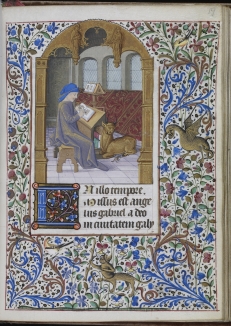As we head north out of Baltimore on I-95, we’ll cross the Delaware River and head into Wilmington, where there are manuscripts to be found at the University of Delaware.
The pre-1600 manuscripts at the University are part of a collection with the shelfmark “MSS 095.” There’s a list of the relevant records here and some highlights are described here. Of particular interest to me is a relatively recent acquisition, U. Delaware MSS 095 no. 31, a Book of Hours for the use of Noyon. There aren’t any images on the Special Collections website, but there are a few on this blogpost written by a Special Collections staff member, as well as a little information about the manuscript’s history. But I’d like to know more…how did it get to Delaware, and what can be gleaned about its history before that?
To answer that question, I’ll do what I always do when I have a provenance problem to solve: hop on the virtual superhighway and head to Philadelphia to visit the Schoenberg Institute for Manuscript Studies at the University of Pennsylvania.
In addition to being an actual institute in an actual library with actual staff organizing actual symposia and caring for actual (beautifully digitized) manuscripts, the Schoenberg Institute is responsible for some significant and important data curation, as it is the home of the Schoenberg Database of Manuscripts. This is an extraordinary resource that has changed the field of provenance research, and we have collector and Big Data visionary Lawrence J. Schoenberg (1932-2014) to thank for it.
Larry Schoenberg (pictured here with his wife Barbara Brizdle) was a passionate collector of books and manuscripts, and the greater part of his collection now belongs to the University of Pennsylvania, part of the Institute that bears his name. I was fortunate enough to work for Larry back in the 1990s, and throughout that period I came to appreciate him as a savvy collector, an appreciative connoisseur, and a kind and generous man whose enthusiasm was contagious and whose energy was boundless. He passed away earlier this year and will be greatly missed.
As a collector and an innovative businessman (he started out at IBM in the late 1950s), Larry understood both the intellectual importance and financial value of provenance, of the history of the books and manuscripts he owned. In the late 1990s, he acquired a spreadsheet-based dataset of manuscript sales to help with his own research into his collection. With the help of his wife Barbara and a group of student assistants, he began to add to the data by manually entering information, first from his personal collection of auction catalogues and later by systematically combing through the catalogue collections at the Grolier Club in New York or dealers such as Bernard Quaritch in London, eventually turning it into an Access database before finding it a permanent home online at the University of Pennsylvania. There, the database has continued to grow under the curatorship of a creative and brilliant staff who are constantly working on improving the data structure and interface.

One of my favorite Schoenberg manuscripts, a ninth-century Boethius (LJS 101, f. 1v)
Today, the Schoenberg Database is a growing dataset of (as of this writing) 221,408 records pertaining to pre-1600 manuscripts. Each record represents an “appearance” of a particular manuscript, by which I mean a transaction, a catalogue description, or an exhibit. This means that a particular manuscript might have multiple Schoenberg Database records associated with it. If it has appeared at auction or sale several times, each of those transactions might have its own record. I say “might” because even though the database is the largest of its kind, it is still growing as new and legacy catalogues are added. As users and staff discover that particular records represent the same manuscript (at two different sales, for example), those records are linked so that users can begin to track manuscript movements through space and time.
I’ll use the Delaware Book of Hours to show how this works.
From the University’s record, we know several things about the manuscript already:
Book of hours : Use of Noyon
Date: circa 1500
Extent: 130 leaves
Dimensions: 175 x 120 (95 x 60) mm
Lines per page: 20
This is a good amount of information to work with. Using the Advanced Search feature in the Schoenberg Database, we can easily search for “Book of Hours” in the title with a limit of 130 leaves. This results in a list of 111 records. Now we have to narrow it down further to see if we can find any records that pertain to the Delaware manuscript. Clicking on “Liturgical Use” in the limiter options along the right side of the page brings up a browse list of identified Use for those 111 records. Two are for the Use of Noyon:
|
Title: Book Of Hours
Folios: 130
Date: 1500
Place: France, Amiens?
Primary Seller: Sotheby’s
Catalogue: Western manuscripts and miniatures L06241 – 2006/12/05
Lot #: 45
Provenance: Le Camus; Paque
Duplicates: 29454 Title: Book Of Hours
Folios: 130
Date: 1450
Place: France, northern, Amiens
Primary Seller: Pirages
Catalogue: Catalogue 60 – 2011
Lot #: 444
Provenance: Cinot, Jeanne; Camuce(?), Madelaine; Paque, Jean Marie, of Boulogne
|
Now that we know that the manuscript was sold by Sotheby’s on 5 December 2006 (lot 45), we can go to the Sotheby’s website and retrieve their description, which happily includes a few images. In addition, the Sotheby’s description gives details about the manuscript’s origin and later provenance. If we combine that information with what we’ve learned from the Schoenberg Database, we can now tell a fairly complete story of this manuscript’s journey from Picardy to Delaware. The first few owners were women:


























